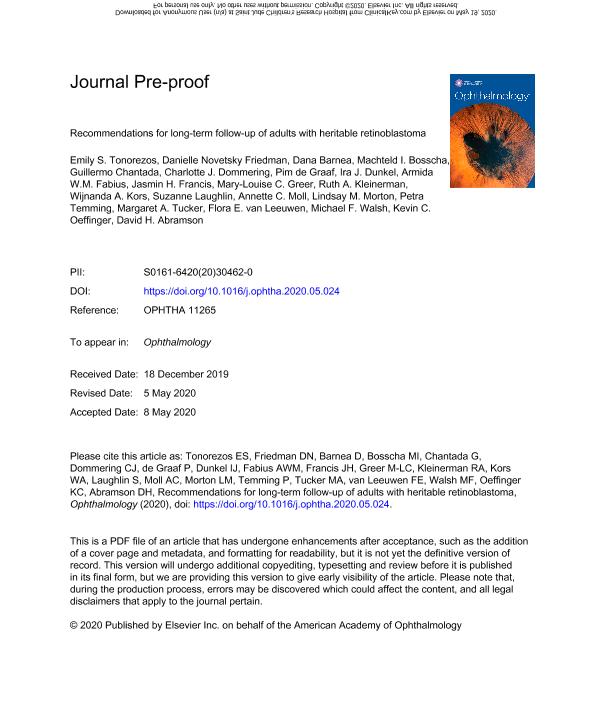Artículo
Recommendations for Long-Term Follow-up of Adults with Heritable Retinoblastoma
Tonorezos, Emily S.; Friedman, Danielle Novetsky; Barnea, Dana; Bosscha, Machteld I.; Chantada, Guillermo Luis ; Dommering, Charlotte J.; de Graaf, Pim; Dunkel, Ira J.; Fabius, Armida W.M.; Francis, Jasmine H.; Greer, Mary Louise C.; Kleinerman, Ruth A.; Kors, Wijnanda A.; Laughlin, Suzanne; Moll, Annette C.; Morton, Lindsay M.; Temming, Petra; Tucker, Margaret A.; van Leeuwen, Flora E.; Walsh, Michael F.; Oeffinger, Kevin C.; Abramson, David
; Dommering, Charlotte J.; de Graaf, Pim; Dunkel, Ira J.; Fabius, Armida W.M.; Francis, Jasmine H.; Greer, Mary Louise C.; Kleinerman, Ruth A.; Kors, Wijnanda A.; Laughlin, Suzanne; Moll, Annette C.; Morton, Lindsay M.; Temming, Petra; Tucker, Margaret A.; van Leeuwen, Flora E.; Walsh, Michael F.; Oeffinger, Kevin C.; Abramson, David
 ; Dommering, Charlotte J.; de Graaf, Pim; Dunkel, Ira J.; Fabius, Armida W.M.; Francis, Jasmine H.; Greer, Mary Louise C.; Kleinerman, Ruth A.; Kors, Wijnanda A.; Laughlin, Suzanne; Moll, Annette C.; Morton, Lindsay M.; Temming, Petra; Tucker, Margaret A.; van Leeuwen, Flora E.; Walsh, Michael F.; Oeffinger, Kevin C.; Abramson, David
; Dommering, Charlotte J.; de Graaf, Pim; Dunkel, Ira J.; Fabius, Armida W.M.; Francis, Jasmine H.; Greer, Mary Louise C.; Kleinerman, Ruth A.; Kors, Wijnanda A.; Laughlin, Suzanne; Moll, Annette C.; Morton, Lindsay M.; Temming, Petra; Tucker, Margaret A.; van Leeuwen, Flora E.; Walsh, Michael F.; Oeffinger, Kevin C.; Abramson, David
Fecha de publicación:
11/2020
Editorial:
Elsevier Science Inc.
Revista:
Ophthalmology
ISSN:
0161-6420
e-ISSN:
1549-4713
Idioma:
Inglés
Tipo de recurso:
Artículo publicado
Clasificación temática:
Resumen
Purpose: To generate recommendations for long-term follow-up of adult survivors of heritable retinoblastoma. Design: We convened a meeting of providers from retinoblastoma centers around the world to review the state of the science and to evaluate the published evidence. Participants: Retinoblastoma is a rare childhood cancer of the retina. Approximately 40% of retinoblastoma cases are heritable, resulting from a germline mutation in RB1. Dramatic improvements in treatment and supportive care have resulted in a growing adult survivor population. However, survivors of heritable retinoblastoma have a significantly increased risk of subsequent malignant neoplasms, particularly bone and soft tissue sarcomas, uterine leiomyosarcoma, melanomas, and radiotherapy-related central nervous system tumors, which are associated with excess morbidity and mortality. Despite these risks, no surveillance recommendations for this population currently are in place, and surveillance practices vary widely by center. Methods: Following the Institute of Medicine procedure for clinical practice guideline development, a PubMed, EMBASE, and Web of Science search was performed, resulting in 139 articles; after abstract and full-text review, 37 articles underwent detailed data abstraction to quantify risk and evidence regarding surveillance, if available. During an in-person meeting, evidence was presented and discussed, resulting in consensus recommendations. Main Outcome Measures: Diagnosis and mortality from subsequent neoplasm. Results: Although evidence for risk of subsequent neoplasm, especially sarcoma and melanoma, was significant, evidence supporting routine testing of asymptomatic survivors was not identified. Skin examination for melanoma and prompt evaluation of signs and symptoms of head and neck disease were determined to be prudent. Conclusions: This review of the literature confirmed some of the common second cancers in retinoblastoma survivors but found little evidence for a benefit from currently available surveillance for these malignancies. Future research should incorporate international partners, patients, and family members.
Palabras clave:
Retinoblastoma
,
Second tumors
,
Survivor
,
Radiotherapy
Archivos asociados
Licencia
Identificadores
Colecciones
Articulos(SEDE CENTRAL)
Articulos de SEDE CENTRAL
Articulos de SEDE CENTRAL
Citación
Tonorezos, Emily S.; Friedman, Danielle Novetsky; Barnea, Dana; Bosscha, Machteld I.; Chantada, Guillermo Luis; et al.; Recommendations for Long-Term Follow-up of Adults with Heritable Retinoblastoma; Elsevier Science Inc.; Ophthalmology; 127; 11; 11-2020; 1549-1557
Compartir
Altmétricas



